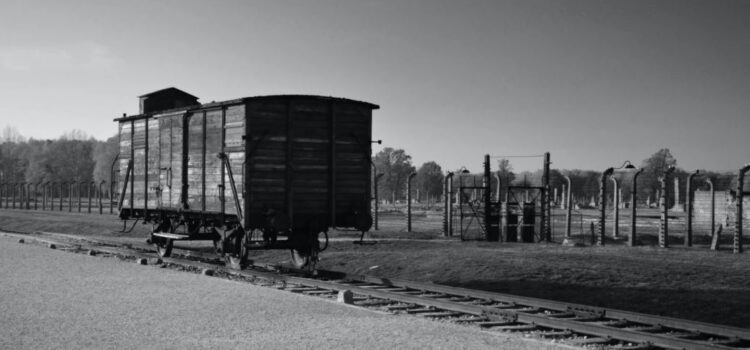

This article is an excerpt from the Shortform book guide to "The Tattooist of Auschwitz" by Heather Morris. Shortform has the world's best summaries and analyses of books you should be reading.
Like this article? Sign up for a free trial here .
Are you looking for The Tattooist of Auschwitz discussion guide? Is The Tattooist of Auschwitz a true story? What were the main events that took place?
The Tattooist of Auschwitz discussion guide goes over the events of the story in chronological order and reminds you of the main characters. You can use this guide as an aid for book club or classroom discussions.
Continue on for The Tattooist of Auschwitz discussion guide.
Is The Tattooist of Auschwitz a True Story?
Before jumping into The Tattooist of Auschwitz discussion guide, it’s important to cover the book’s history first. If you’re wondering if The Tattooist of Auschwitz is a true story, the answer is: partially. The story is based on the accounts of the real-life survivor, Lali Sokolov, as told to the author 70 years after the events. The author has stated that 95% of the story is based on Lali’s retelling and the rest imagined as creative license.
However, certain historical organizations have reported that many of the events described in the novel are inaccurate or outright impossible. Therefore, this story should be viewed as a dramatized account of the characters’ lives based more on memory than factual data and not be taken as a true historical account of what life at Auschwitz was like for the thousands of prisoners held there.
Below is The Tattooist of Auschwitz discussion guide that will cover the main events of the book.
The Tattooist of Auschwitz: Discussion Guide
The Tattooist of Auschwitz discussion guide begins in April 1942. Lale Sokolov, a 25-year-old man from Slovakia, finds himself on a cattle train heading into the night. For five days, Lale and hundreds of men are shuttled cross-country in carriages packed so tightly with bodies, they have to stand for the entire journey. Lale, like most of the young men on the train, has volunteered to work for the Germans in exchange for his family’s safety.
Lale is dressed in a suit and tie. He believes in dressing well and making a good first impression. In his suitcase, he’s packed his other suits and books from his mother. He also has a small sum of money stuffed into his suit pocket. He hopes that between the money, his ability to speak 6 languages, and his professional appearance, he’ll be able to secure a high-level job once they reach the labor camp.
At last, the train stops, and the men are herded off. In front of them stands the gates to Auschwitz, the concentration camp that will take many of their lives in the years to come. The men are told to leave their possessions by the train. Some men refuse and are shot on the spot. Lale sets his suitcase down and joins the line of men waiting to get tattooed with their camp numbers. He wonders how they’ll know which suitcase is his.
In the flurry of barking dogs and screaming SS officials, Lale witnesses other men gunned down for no reason. He begins to realize he will never see his possessions again. He also realizes he may never see the outside world again. He makes a promise to survive however he can and one day walk away a free man.
Year One: 1942-1943
Lale was always a fast-talking charmer back home in Bratislava, and his charm comes in handy at the camp. He inspires the other men around him and works his way into the good graces of the guards. Some of the men believe that Lale is the chosen one who will save them all. This belief ends up saving his life when he falls ill with typhus. At the onset of the illness, Lale is so weak and sickly, the SS officers throw his body on a transport out of the camp filled with dead bodies. But one young man pulls him down and hides him in their barracks.
The other prisoners rally to nurse Lale back to health. One of these prisoners is a French professor, who also wants to help the man so many are risking their lives to save. He offers Lale the opportunity to work with him as a tattooist, a job that comes with many perks. Lale isn’t sure he wants to help the Nazis defile his people, but he’d rather it be him than someone less caring, so he accepts.
For weeks, Lale helps brand the hundreds to thousands of new arrivals entering the camp daily. One day, Lale tattoos the arm of a woman who captivates his heart. He knows nothing else about her but her camp number, but he vows to learn more. After the French professor vanishes, Lale is made head tattooist. This position earns him private sleeping quarters, better food and bigger rations, and the ability to move freely through the camp.
Lale uses his good fortune to help feed the other prisoners and devises a plan to do more. He arranges for women working in the warehouses where the confiscated possessions are sorted to smuggle jewelry and cash to him in exchange for extra food. He uses the valuables to pay a civilian worker from a nearby town to bring him supplies, including medicine and chocolate.
Lale’s business enterprise runs smoothly, and he gets a reputation for being able to help prisoners in difficult situations. He also uses his power to court the young woman he can’t stop thinking about. He sends her a letter through a friendly SS officer, and the two finally meet. Her name is Gita, and she is as enchanted by Lale as he is by her. They begin meeting in secret, and their love blooms despite their horrifying surroundings.
Lale’s promise to escape the camp now includes Gita, and everything he does is now attached to making her life at the camp easier. He feeds her chocolate and watches her face come to life. He steals a chocolate-y kiss, and they swoon like teenagers. He also arranges for her to work in the administration building where it’s warm and safe. He tells her that one day they will marry and have a family, and despite her despair, Gita starts to believe him.
Year Two: 1943-1944
During spring 1943, thousands of Romanian nomads, referred to as gypsies, are brought to the camp and become Lale’s neighbors in his block. Lale and the Romany grow close, especially one older woman named Nadya, who reminds Lale of his mother. He spends his nights talking to the men and learning about their culture, and he encourages the older women to start an informal school for the children.
Lale settles into a routine at the camp. He does his work diligently and continues his extracurricular activities, acquiring a stash of jewels and food that barely fits under his mattress. His relationships with both the Romany, whom he now considers his new family, and Gita also flourish.
Yet amid these successes, Lale witnesses many horrors. A new doctor comes to camp and abuses and tortures hundreds of prisoners, mostly women. Five crematoriums are built, and the ashes of murdered prisoners rain down over the camp almost daily. More prisoners are transported to the camp regularly, sometimes numbering in the thousands, and Lale often works around the clock tattooing all of them.
The harsh winter takes many lives that year. Lale uses his connections to try to help as many prisoners as he can, including Gita when she falls ill, but death abounds. He struggles with his protected position, knowing he is helping the enemy and living a better life because of it. Still, if his position helps him and Gita live to see the end of the war, it’s worth it.
One day, a small glimmer of hope settles over the camp. An American bomber plane flies over several times. Prisoners cheer and wave to get the pilot’s attention, and some urge the pilot to bomb the crematoriums. But the plane flies away, and the SS open fire on the dissenters. Some of the Romany children Lale is fond of are shot in this firestorm, and he mourns them greatly.
Year Three: 1944-1945
Lale learns some disturbing news from Gita one night. Her friend, Cilka, has been forced to carry on a sexual affair with one of the commanding officers for a year. Lale is outraged, even more so that there is little he can do about it. But this information comes in handy in the coming weeks.
One day, Lale returns to his room to find SS officers waiting for him, his stash of valuables discovered. He is taken to the punishment barracks and beaten to entice him to turn over the names of the people who helped him. Fortunately, the person torturing Lale is another prisoner, a large Jewish man the SS have ordered to perform these beatings, who Lale helped the night the man arrived at camp. He was starving, and Lale gave him all of his food rations. Because of this, the man feigns his abuse and convinces the officers that Lale has no information to give.
Lale is sent to work hard labor after that. He and other men are forced to carry heavy boulders back and forth across an open field. The last man to cross the line is shot. Lale is weak from the beatings and knows he won’t survive. He asks his friendly SS officer to tell Gita and Cilka where he is. Cilka convinces her abuser to help Lale, and the next day, Lale is back in his old room and given his old job back.
Although Lale almost dies, this isn’t the worst thing that happens to him. The tipping point for Lale is when the Romany are rounded up one night and taken away. He tries to convince Nadya to stay with him, but she has no choice but to go with her people. The next day, Lale is tattooing new arrivals when an ash lands on his arm. He looks up and sees a thick plume of smoke rising from a crematorium. He knows the ashes belong to the Romany, and he falls apart. Over the next few weeks, with Gita’s help, Lale recovers from his despair, but a new fury is born.
Afterward: 1945 and Beyond
Lale and the other prisoners hear news of a Russian invasion, and an uprising occurs. Two crematoriums are destroyed by homemade bombs made from sardine cans and gunpowder smuggled out under the fingernails of munitions workers. Although many die as a result of the uprising and the Russians never come, the Germans are clearly shaken. They start shipping prisoners to other camps. The end of Auschwitz is near.
Gita and the other women are rounded up and marched out of the camp late one night. Lale tries to catch up to her before she leaves, but he’s stopped by the SS. He yells over the crowd that he loves her, and Gita yells her last name, Furman, something she had said she wouldn’t tell him until they were free.
Gita and the other women are forced to march for days. After her only friend dies along the journey, Gita befriends four Polish girls. When they reach a train waiting to take them to another camp, the five women decide to flee. There are so many women and so few guards, nobody notices when they take off through a nearby field.
The women find a small village where someone agrees to hide them. Finally, the Russians arrive and force the Germans out, and the women are allowed to move around freely. Gita finds a ride with a produce delivery man to her hometown of Bratislava. She’s heard rumors that her parents and sister are dead, but she is overjoyed when she returns home and finds her two brothers are still alive. She registers with the Red Cross and starts her life over.
Lale leaves on a transport of men and is sent to another camp in Austria. Eventually, he is transferred again to Vienna, where he finally makes his escape. But instead of finding help, he ends up in the hands of Russian officials, who capture him and put him to work as a pimp for the commanding officers. The best part about this job is that Lale is given cash and jewelry to entice his female targets. He is able to pocket a few gems and bides his time. After earning the Russians’ trust, Lale is allowed to visit the women in the village on his own. He takes his collection of jewels and runs away as soon as he is by himself. He uses the jewels to buy transport back home.
Lale arrives home to find his parents and brother gone, but his younger sister is still alive. He tells her about Gita, and she encourages him to go find her. Lale goes to Bratislava, where he’s heard survivors are heading. He searches for Gita and finds her information through the Red Cross registry. The two are reunited, and in October 1945, Gita and Lale are married.
The Tattooist of Auschwitz discussion guide ends with the epilogue. Lale and Gita eventually move to Australia and have a son. For more than 50 years, they live happily together, loving each other as much as they did during those long years in captivity.

———End of Preview———
Like what you just read? Read the rest of the world's best book summary and analysis of Heather Morris's "The Tattooist of Auschwitz" at Shortform .
Here's what you'll find in our full The Tattooist of Auschwitz summary :
- How a man used tattooing skills to stay alive at Auschwitz-Birkenau
- How Lale Sokolov fell in love in these unusual circumstances
- How Lale goes from concentration camp to Russian prisoner before finding freedom






